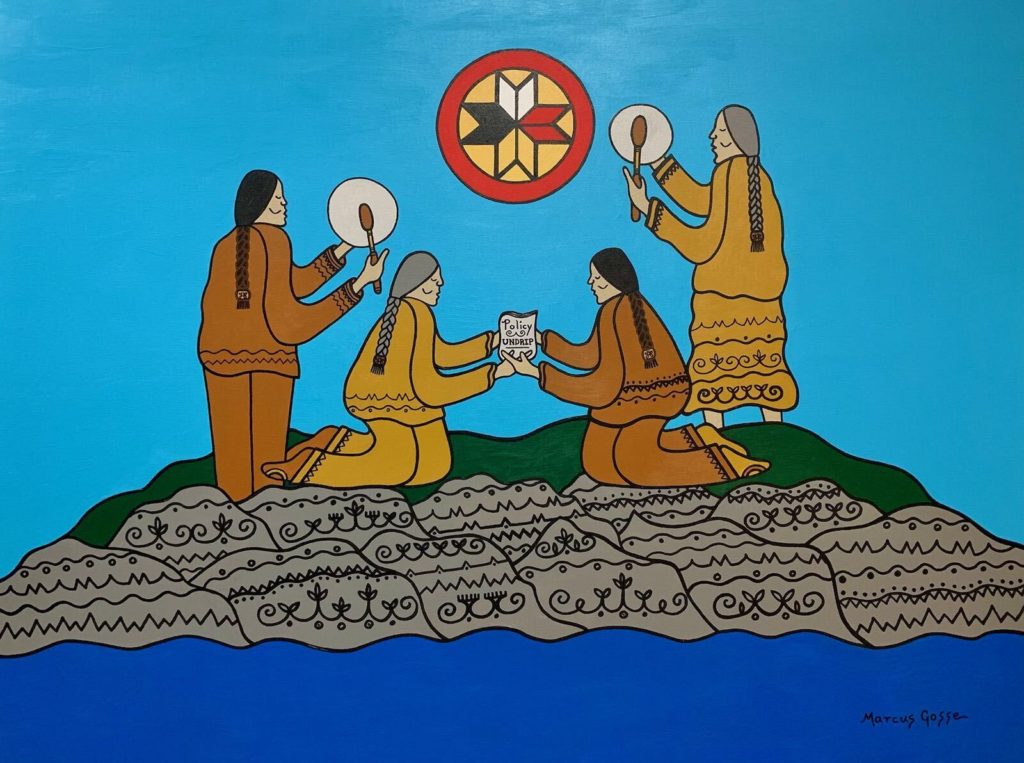
Marcus Gosse

ABOUT THE ARTIST
Marcus Gosse is a Newfoundland Mi’kmaw Artist, and a member of the Qalipu Mi’kmaq First Nation Band in Newfoundland. Marcus’ grandmother, Alice Maude Gosse (maiden name Benoit), is a Mi’kmaq Elder, who was born and raised in Red Brook, NL (Welbooktoojech) located on the Port-au-Port Peninsula.
In 2005, Marcus was given his native name Papamikapow, which means “Traveler” (he who travels, not only physically, but, spiritually) from an Ojibway-Cree Elder from Sandy Lake First Nation, Ontario. Marcus incorporates the ancient Mi’kmaq Star, Mi’kmaq Petroglyphs, Hieroglyphs, and various double curve designs into the landscapes of his paintings.

Title: “Cultural Awakening”
Mi’kmaq Artist: Marcus Gosse
Mi’kmaq Name: Ala’suinu – Traveller
Medium: Acrylic on Canvas
Size: 3 feet (width) x 4 feet (length)
Date Completed: 2022
Commission: Artist in Residence, First Peoples Policy Forum, Winter 2022 (December 12-13)
DESCRIPTION
This painting, titled “Cultural Awakening,” displays four people honouring and embracing the cultural rights of Mother Earth. The Elder and youth are drumming to honour cultural rights, and to show honour to the land, their ancestors, and each other. The other people in the painting are embracing policy as a means of recognizing and advancing our cultural rights. They are also praying that all Indigenous people will have their rights and freedoms to express their culture respected.
In their hands is a copy of the United Nations Declaration on the Rights of Indigenous Peoples (UNDRIP), which describes the inherent rights that all Indigenous Peoples have to practice, develop, and teach their spiritual traditions, customs, and ceremonies.
This painting displays petroglyphs (carvings in stone) such as the Mi’kmaq Eight-Pointed Star, double curve designs, and appliqué patterns. The Mi’kmaq Star represents unity amongst all the cultures of the world. The double curve designs symbolize the lifecycle of human beings and all living things. The curve on the left represents youth; the centre middle age; and the curve on the right represents becoming a senior or Elder. The connection between the double curves represents people holding hands, supporting their culture and each other. The appliqué patterns are commonly found on traditional women’s peaked hats and men’s long coats.
The rocks and the peoples’ clothes both contain these Mi’kmaq Petroglyphs. The artist’s intention is to show that the people are connected with the land and their culture. The rocks, painted in black and grey, are intended to replicate the petroglyph landscape at Kejimkujik National Park in Nova Scotia to show the importance of preserving our cultural knowledge for future generations.
Together, these symbols represent the need to embrace culture, connect with our community, preserve our cultural knowledge, and honour the land, our ancestors, and each other.
Msit No’kmaq (All Our Relations; We Are All Connected).